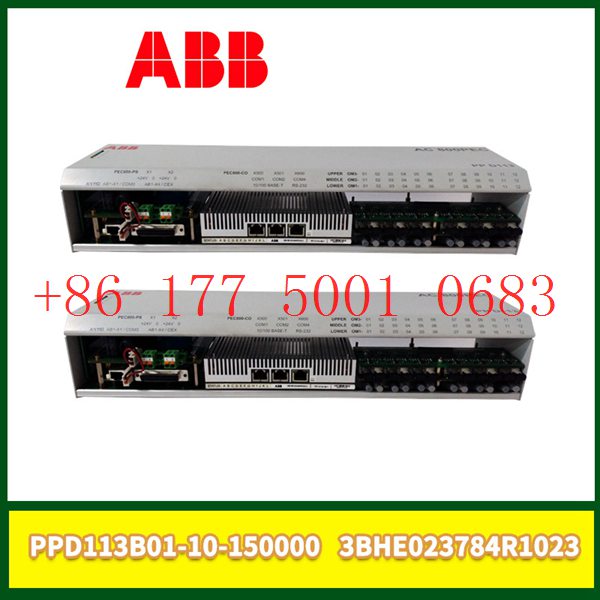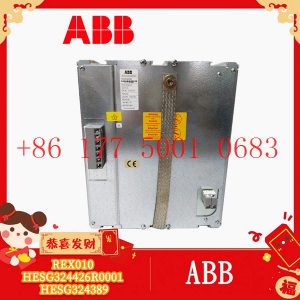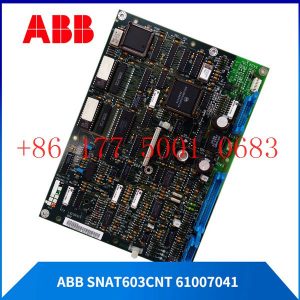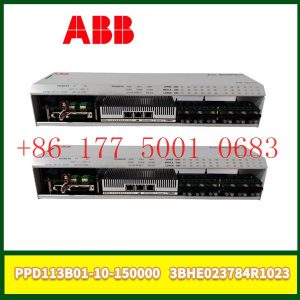Description
hardware flow control. It is an ideal choice in the field of industrial automation.
Implementation of communication between ABC industrial robot and PLC based on DeviceNet fieldbus technology
introduction
In modern production systems, industrial robots and PLCs need to communicate and collaborate to complete production tasks. That is, the
industrial robots output signals to the PLC, allowing the PLC to control related equipment to drive the robot”s front-end tools. This article
mainly analyzes the communication problems between ABB industrial robots and PLC based on DeviceNet fieldbus technology.
DeviceNet is a common network communication method in the field of automation. ABB industrial robots establish a network to communicate with
Siemens PLC based on the DeviceNet network.
1Configure DSQC652
There are mainly 5 types of standard I/0 boards commonly used in ABB industrial robots [2]. Except for the different addresses assigned to
them during setup, their configuration methods are basically the same. This article mainly analyzes the ABB standard I/0 board DS0C652, which
mainly builds communication modules based on the DeviceNet network. The DS0C652 board has a distributed I/O module with 16 digital input and 16
digital output interfaces. The board is installed in the ABB industrial robot control cabinet. First, define the specific operation steps of the DS0C652 board,
enter the teach pendant control panel, then enter the configuration menu (Figure 1), select the DeviceNetDevice menu, and add a template to enter Figure 2.
ABB standard I/0 board is hung on the DeviceNet
network, so the address of the module in the network must be set. The jumpers 6 to 12 of terminal x5 are used to determine the address of the module.
The available address range is 10 to 63. Modify the parameters in the template parameters to complete the DS0C652 board settings. Click the drop-down
menu to select the “Use value from template” row, select
“DS0C65224VDCI/0Device”, and then the parameters that need to be set include the address of the I/0 board in the bus.
Figure 1 Configuring DSQC652
2Configure signals and parameters
After completing the DS0C652 board setting, the I/0 signal setting will be performed. Setting the I/0 signal is the basis for establishing communication with
the PLC. The PLC communicates and transmits data with the ABB industrial robot through the I/0 signal and the DS0C652 board. As shown in Figure 3, in the
signal configuration interface, there are many default I/0 points after the system is established. Modification is not allowed. Click “Add” to add signals. When setting
input and output signals, their address range is 0~15. First, enter the signal menu in the configuration options to set the input and output types, and modify the corresponding parameters.
After completing the settings, the computer prompts that you need to restart the settings. If there are multiple signals that need to be defined and the waiting time
is long after restarting multiple times, you can click “Cancel” and wait for all signals to be defined before clicking the “Yes” button to restart. After the signal settings are
completed, click to select “Input and Output” in the ABB menu to check whether all signals have been set.
Figure 2 Configure DSQC652 parameters
Figure 3 Signal parameter settings
During the signal establishment process, attention should be paid to the DSoC652 port and PLC port addresses used, and the corresponding address table should be
established, as shown in Table 1. The robot interacts with the PLC through I/O signals. During the setting process, there must be no errors in the port and address number
of the PLC connected to the DSoC652. If the address is set incorrectly, the communication between the robot and the PLC will not work properly.
The entire robot teaching pendant setting process is shown in Figure 4.
Excitation system ABB module 3AFE61320946P0001 POS.A6091
Excitation system ABB module 3ADT316300R1510 SDCS-PIN-4B
Excitation system ABB module 3ABD10058721DX5221
Excitation system ABB module 37911-4-0338125
Excitation system ABB module 23BA20D
Excitation system ABB module 216VC62a HESG324442R13/E
Excitation system ABB module 216VC62A HESG324442R112/F
Excitation system ABB module 216VC62a
Excitation system ABB module 216VC62A
Excitation system ABB module 216NG63A HESG441635R1
Excitation system ABB module 216NG63
Excitation system ABB module 216NG62A HESG441634R1/K
Excitation system ABB module 216NG61A HESG441633R1
Excitation system ABB module 216GD61a
Excitation system ABB module 216EA62 1MRB150083R1/F
Excitation system ABB module 216EA61b
Excitation system ABB module 216DB61 HESG324063R100/J
Excitation system ABB module 216DB61
Excitation system ABB module 216AB61
Excitation system ABB module 216AB61
Excitation system ABB module 1VCF752000
Excitation system ABB module 1TGE120028R0010
Excitation system ABB module 1TGE120028R0010
Excitation system ABB module 1TGE120021R0110
Excitation system ABB module 1TGE120021R0110
Excitation system ABB module 1TGE120021R0010
Excitation system ABB module 1tge120011r1001
Excitation system ABB module 1TGE120011R1000
Excitation system ABB module 1TGE120010R1300
Excitation system ABB module 1TGE120010R
Excitation system ABB module 1TGE106170M4200
Excitation system ABB module 1TGB302003R0003
Excitation system ABB module 1SVR450081R0000
Excitation system ABB module 1SVR360663R1001
Excitation system ABB module 1SVR040000R1700
Excitation system ABB module 1SVR011718R2500
Excitation system ABB module 1SVR011718R2500
Excitation system ABB module 1SNA684252R0200
Excitation system ABB module 1SFB536068D1011
Excitation system ABB module 1SBP260022R1001
Excitation system ABB module 1SAR700012R0005
Excitation system ABB module 1SAP530100R0001
Excitation system ABB module 1SAP520100R0001
Excitation system ABB module 1SAP173200R0001
Excitation system ABB module 1SAP150000R0170 PM590-ETH
Excitation system ABB module 1SAJ520000R0101 UMC100
Excitation system ABB module 1MRS050644
Excitation system ABB module 1MRS050644
Excitation system ABB module 1MRS050496
Excitation system ABB module 1MRK002246-BD
Excitation system ABB module 129765-008
Excitation system ABB module 129740-102
Excitation system ABB module 129740-002
Excitation system ABB module 129740-002
Excitation system ABB module 128877-103
Excitation system ABB module 086444-005
Excitation system ABB module 086407-502
Excitation system ABB module 086370-001
Excitation system ABB module 086370-001
Excitation system ABB module 086349-002
Excitation system ABB module 086345-504
Excitation system ABB module 086339-501
Excitation system ABB module 086339-001
Excitation system ABB module 086329-004
Excitation system ABB module 086329-004
Excitation system ABB module 086329-003
Excitation system ABB module 086318-002
Excitation system ABB module 086318-002









Reviews
There are no reviews yet.